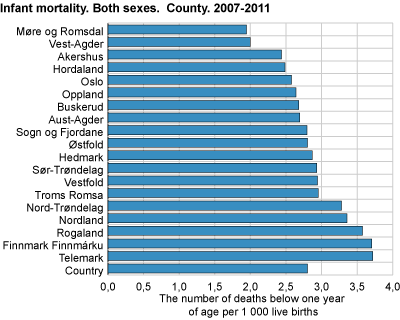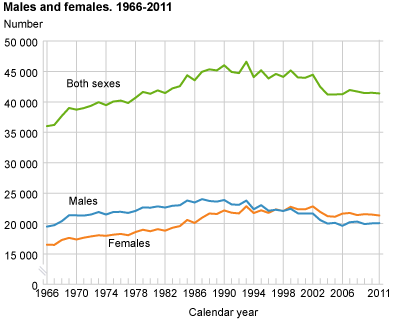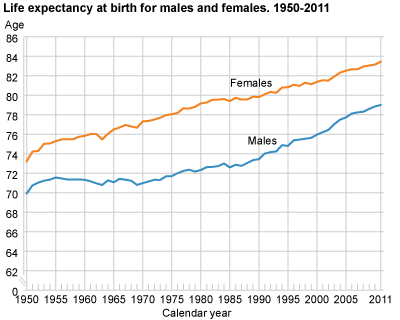Content
Published:
This is an archived release.
Life expectancy increase and low infant mortality
In 2011, life expectancy at birth increased and infant mortality was lower than ever before. Decreasing mortality among the elderly and middle-aged contribute most to the increase in life expectancy.
Infant mortality, defined as the number of persons who die below one year of age per 1 000 live births in the same period, reached a new low in Norway in 2011; 2.4. Over the last three years, infant mortality has been 2.9, and is now much lower than in 1976, when it was in excess of 10 per 1 000 live births. Infant mortality is usually lower for girls than boys. In 2011, it was 3.0 for boys and 1.7 for girls.
Few infants die in the Nordic region
In Norway, infant mortality is not particularly low compared to the other Nordic countries, where it is among the lowest in the world. In 2010, infant mortality in Norway was 2.8, in Iceland 2.2, Finland 2.3 and Sweden 2.5. Other countries with low mortality are Japan with 2.3 and France with 3.6.
Møre og Romsdal was the county with the lowest infant mortality in the period 2007-2011, with 1.9 and Vest-Agder with 2.0. Telemark and Finnmark had the highest infant mortality in the same period with 3.7. The average for the country was 2.8. County figures may randomly vary slightly from year to year.
Life expectancy still increasing
In 2011, newborn boys can expect to live for 79.0 years and newborn girls for 83.5 years. This is an increase in life expectancy from the year before of 0.1 for boys and 0.3 for girls. The increase is caused by reduced mortality in most age groups. However, higher mortality in some younger age groups may be a coincidence and may not affect the life expectancy. Men have had a favourable development in life expectancy for some time, but not from 2010 to 2011. Twenty-five years ago, newborn girls could expect to live 6.9 years longer than boys. In 2011, the difference has sunk to 4-5 years longer.
Icelanders and Swedish live longest
Among the Nordic countries, women in Iceland and Sweden can expect to live the longest; about 83.6 years in 2011. This is only 0.1 year longer than in Norway. The highest life expectancy for women is in Japan, with 86.4 years (2010). For men, life expectancy is highest in Iceland and Sweden, with 79.9 years and 79.7 years respectively. In Norway, life expectancy was almost one year lower than in Iceland but nearly two years higher than in Denmark and Finland.
41 400 died last year
In 2011, 41 400 people died. This is a decrease of 100 deaths compared to the year before. A total of 21 300 women and 20 100 men died. Of these, 142 were children below one year of age; 92 boys and 50 girls.
Tables:
- Table 1 Deaths and death rates 1961-2011
- Table 2 Age-specific death rates for males and females. 1971-2011
- Table 3 Life expectancy - remaining years for males and females at selected ages. 1866-2011
- Table 4 Perinatal and infant mortality. 1956-2011
- Table 5 Life tables, 2011
- Table 6 Life expectancy - remaining years for males and females at selected ages, by county. 1971-2010
Contact
-
Anders Sønstebø
E-mail: anders.sonstebo@ssb.no
tel.: (+47) 46 66 37 74
-
Magnus Haug
E-mail: magnus.haug@ssb.no
tel.: (+47) 40 81 14 91
-
Ane Margrete Tømmerås
E-mail: ane.tommeras@ssb.no
tel.: (+47) 91 99 29 62
-
Statistics Norway's Information Centre
E-mail: informasjon@ssb.no
tel.: (+47) 21 09 46 42
-
Oppdrag befolkningsstatistikk
E-mail: befolkning@ssb.no


![Infant mortality for boys, girls and both sexes. 1976-2011].](/a/en/static/dode_en/fig-2012-04-19-01-en.gif)

